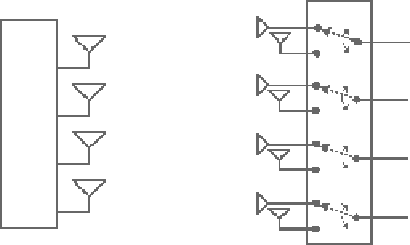Digital Signal Processing Reference
In-Depth Information
Y-Polarized
Z-Polarized
Tx
Rx
FIgure 4.19
Adaptive polarization technique (AMPAS) at Rx.
that the average received power is normalized and the channel attenuation is neglected.
Subsequently, the variation of polarization is characterized only by the XPD effects.
As shown in
Figure 4.17
, this phenomenon affects directly the performance of non-
polarized MIMO systems. In the single-polarization communications case, low XPD
causes higher losses in channel power; in other words, there is some sort of mismatch in
polarization. That is why we will apply adaptive techniques to reduce this mismatch in
the polarization of MIMO systems. This technique is called adaptive MIMO polarized-
antenna selection technique (AMPAS). The principle of this method is to choose properly
the antenna polarizations that optimize the receiving signal power while minimizing
fading correlation antenna effects. In Figure 4.19, an example of an adaptive polariza-
tion system employing four
z
-oriented dipoles at Tx and four pairs of
y
- and
z
-oriented
dipoles at Rx is illustrated. Simulation results based on three-dimensional ray-tracing
techniques show that the channel capacity obtained by an adaptive polarization increases
7-13% in comparison to the single-polarization channel capacity.
Another example of an adaptive polarization system is based on the rotation of the
antenna elements according to the polarization of traveling waves at Rx. The proposed
MIMO system consists of
P
half-wavelength dipole antennas that are rotated against one
another by the rotation angle γ = 180°/
P
with phase centers at the same point at both Tx
and Rx.
Figure 4.20
demonstrates the obtained performances of 1 × 1 SISO, 1 × 2 SIMO, and
2 × 2 MIMO communication systems while the receiving antenna is rotating on the
y-z
plane with χ
θ
and χ
ϕ
~ N(0,5). Performance can be better enhanced if polarization at
the Rx is properly matched to that of incident waves. In contrast, it can be worse if they
are not well matched, as shown in Figure 4.20a (at rotational angle (γ) ≈ 140°). Thus,
for improving the MIMO channel capacity, the receiving antenna elements should be
rotated to find maximum receiving signals while minimizing fading correlation antenna
effects.
While the other systems employ only
z
-oriented dipoles at Tx and
y
- and
z
-oriented
dipoles at Rx in the case of the same antenna position (b and c) and the λ/2-separated
antenna elements (d), the rotations of two dipoles on plane
y-z
can provide different
performances, as shown in Figure 4.20b-
d
. The channel performance is maximized
in Figure 4.20b when the polarizations of receiving antennas are well matched, and

Search WWH ::

Custom Search